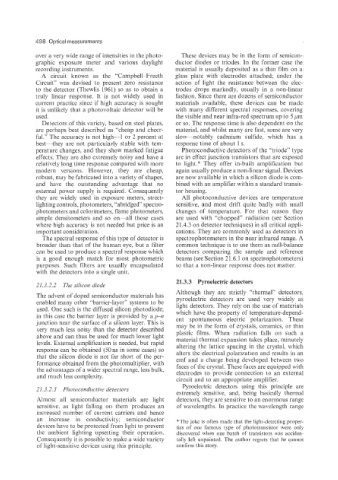Page 515 - Instrumentation Reference Book 3E
P. 515
498 Optical measurements
over a very wide range of intensities in the photo- These devices may be in the form of semicon-
graphic exposure meter and various daylight ductor diodes or triodes. In the former case the
recording instruments. material is usually deposited as a thin film on a
A circuit known as the “Campbell-Freeth glass plate with electrodes attached; under the
Circuit” was devised to present zero resistance action of light the resistance between the elec-
to the detector (Thewlis 1961) so as to obtain a trodes drops markedly, usually in a non-linear
truly linear response. It is not widely used in fashion. Since there are dozens of semiconductor
current practice since if high accuracy is sought materials available, these devices can be made
it is unlikely that a photovoltaic detector will be with many different spectral responses, covering
used. the visible and near infra-red spectrum up to 5 pm
Detectors of this variety, based on steel plates, or so. The response time is also dependent on the
are perhaps best described as “cheap and cheer- material, and whilst many are fast, some are very
ful.” The accuracy is not high-1 or 2 percent at slow-notably cadmium sulfide. which has a
best-they are not particularly stable with tem- response time of about 1 s.
perature changes, and they show marked fatigue Photoconductive detectors of the “triode” type
effects. They are also extremely noisy and have a are in effect junction transistors that are exposed
relatively long time response compared with more to light.” They offer in-built amplification but
modern versions. However, they are cheap, again usually produce a non-linear signal. Devices
robust, may be fabricated into a variety of shapes, are now available in which a silicon diode is com-
and have the outstanding advantage that no bined with an amplifier within a standard transis-
external power supply is required. Consequently tor housing.
they are widely used in exposure meters, street- All photoconductive devices are temperature
lighting controls, photometers, “abridged” spectro- sensitive, and most drift quite badly with small
photometers and colorimeters, flame photometers, changes of temperature. For that reason they
simple densitometers and so on-all those cases are used with “chopped” radiation (see Section
where high accuracy is not needed but price is an 21.4.3 on detector techniques) in all critical appli-
important consideration. cations. They are commonly used as detectors in
The spectral response of this type of detector is spectrophotometers in the near infrared range. A
broader than that of the human eye, but a filter common technique is to use them as null-balance
can be used to produce a spectral response which detectors comparing the sample and reference
is a good enough match for most photometric beams (see Section 21.6.1 on spectrophotometers)
purposes. Such filters are usually encapsulated so that a non-linear response does not matter.
with the detectors into a single unit.
21.3.3 Pyroelectric detectors
21.3.2.2 The silicon diode
Although they are strictly “thermal” detectors,
The advent of doped semiconductor materials has pyroelectric detectors are used very widely as
enabled many other “barrier-layer’’ systems to be light detectors. They rely on the use of materials
used. One such is the diffused silicon photodiode; which have the property of temperature-depend-
in this case the barrier layer is provided by a p-n ent spontaneous electric polarization. These
junction near the surface of a silicon layer. This is
very much less noisy than the detector described may be in the form of crystals, ceramics, or thin
plastic films. When radiation falls on such a
above and can thus be used for much lower light material thermal expansion takes place, minutely
levels. External amplification is needed, but rapid
response can be obtained (50 ns in some cases) so altering the lattice spacing in the crystal, which
alters the electrical polarization and results in an
that the silicon diode is not far short of the per- emf and a charge being developed between tm7o
formance obtained from the photomultiplier, with faces of the crystal. These faces are equipped with
the advantages of a wider spectral range, less bulk,
and much less complexity. electrodes to provide connection to an external
circuit and to an appropriate amplifier.
Pyroelectric detectors using this principle are
21.3.2.3 Photoconductive detectors
extremely sensitive, and, being basically thermal
Almost all semiconductor materials are light detectors, they are sensitive to an enormous range
sensitive, as light falling on them produces an of wavelengths. In practice the wavelength range
increased number of current carriers and hence
an increase in conductivity: semiconductor *The joke is often made that the light-detecting proper-
devices have to be protected from light to prevent ties of one famous type of phototransistor were only
the ambient lighting upsetting their operation. discovered when one batch of transistors was acciden-
Consequently it is possible to make a wide variety tally left unpainted. The author regrets that he cannot
of light-sensitive devices using this principle. confirm this story.

